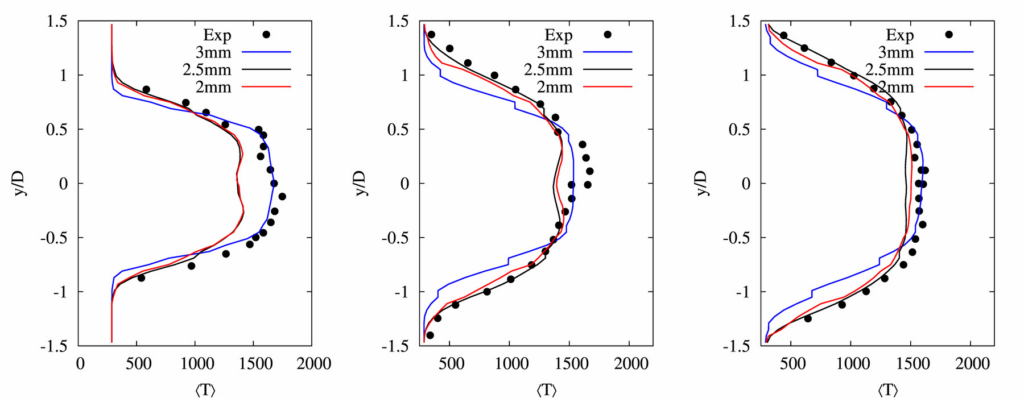
Author:
Erik Tylczak
Senior Research Engineer
Any CONVERGE user knows that our solver includes a lot of physical models. A lot of physical models! How many combinations exist? How many different ways can you set up a simulation? That’s harder to answer than you might think. There might be N turbulence models and M combustion models, but the total set of combinations isn’t N*M.
Why not? In some cases, our developers haven’t completed it yet! The ECFM and ECFM3Z combustion models, for example, could not be combined with a large eddy simulation (LES) turbulence model until CONVERGE version 3.0.11. We’re adding more features all the time. One interesting example is the thickened flame model (TFM).
The name is descriptive, of course: TFM is designed to thicken the flame. If you’re not a combustion researcher, this notion may not be intuitive. A real flame is thin (in an internal combustion engine environment, tens or hundreds of microns). Why would we want to design a model that intentionally deviates from this reality? As is often the case with physical modeling, the answer lies in what we’re trying to study.
CONVERGE is often used to study the engineering operability of a premixed internal combustion or gas turbine engine. This requires accurate simulation of macroscopic combustion dynamics (flame properties), including the laminar flamespeed. A large eddy simulation (LES) might use cells on the order of 0.1 mm.
The problem may now be clear. The flame is much too thin to resolve on the grid we want to use. In fact, a detailed chemical kinetics solver like SAGE requires five or more cells across the flame in order to reproduce the correct laminar flamespeed. An under-resolved flame results in an underprediction of laminar flamespeed. Of course, we could simply decrease the cell size by an order of magnitude, but that makes for an impractical engineering calculation.
The thickened flame model is designed to solve this problem. The basic idea of Colin et al.1 was to simulate a flame that is thicker than the physical one, but which reproduces the same laminar flamespeed. From simple scaling analysis, this can be achieved by increasing the thermal and species diffusivity while reducing the reaction rate by a factor of F. Because the flame thickening effect decreases the wrinkling of the flame front, and thus its surface area, an efficiency factor E is introduced so that the correct turbulent flamespeed is recovered.
The combination of these scaling factors allows CONVERGE to recover the correct flamespeed without actually resolving the flame itself. CONVERGE also calculates a flame sensor function so that these scaling factors are applied only at the flame front. By using TFM with SAGE detailed chemistry, a premixed combustion engineering simulation with LES becomes practical.
Hasti et al.2 evaluated one such case using CONVERGE with LES, SAGE, and TFM. This work examined the Volvo bluff-body augmentor test rig, shown below, which has been subjected to extensive study. At the conditions of interest, the flame thickness is estimated to be about 1 mm, and so SAGE without TFM should require a grid not coarser than 0.2 mm to accurately simulate combustion.

With TFM, Hasti et al. show that CONVERGE is able to generate a grid-converged result at a minimum grid spacing of 0.3125 mm. We might expect such a calculation to take only about 40% as many core hours as a simulation with a minimum grid spacing of 0.25 mm.




Understanding the topic of study, the underlying physics, and the way those physics are affected by our choice of physical models, are critical to performing accurate simulations. If you want to combine the power of the SAGE detailed chemical kinetics solver with the transient behavior of an LES turbulence model to understand the behavior of a practical engine–and to do so without bankrupting your IT department–TFM is the enabling technology.
Want to learn more about thickened flame modeling in CONVERGE? Check out these TFM case studies from recent CONVERGE User Conferences (1, 2, 3) and keep an eye out for future Premixed Combustion Modeling advanced training sessions.
[1] Colin, O., Ducros, F., Veynante, D., and Poinsot, T., “A thickened flame model for large eddy simulations of turbulent premixed combustion,” Physics of Fluids, 12(1843), 2000. DOI: 10.1063/1.870436
[2] Hasti, V.R., Liu, S., Kumar, G., and Gore, J.P., “Comparison of Premixed Flamelet Generated Manifold Model and Thickened Flame Model for Bluff Body Stabilized Turbulent Premixed Flame,” 2018 AIAA Aerospace Sciences Meeting, AIAA 2018-0150, Kissimmee, Florida, January 8-12, 2018. DOI: 10.2514/6.2018-0150
[3] Sjunnesson, A., Henrikson, P., and Lofstrom, C., “CARS measurements and visualizations of reacting flows in a bluff body stabilized flame,” 28th Joint Propulsion Conference and Exhibit, AIAA 92-3650, Nashville, Tennessee, July 6-8, 1992. DOI: 10.2514/6.1992-3650


